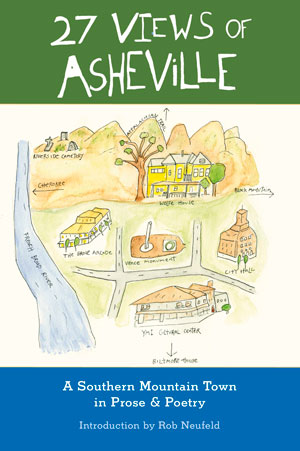by Vicky Dickson

When I was an undergraduate at UNC back in the day, my then-boyfriend (and now-husband) and I used to make regular trips to Person Hall. Not for classes – in fact, we didn’t even enter the building – we just came to admire the angel carved in stone that was displayed outside, and ponder its haunting inscription: “O lost, and by the wind grieved, ghost, come back again.â€
Though the carving inspired us to make our way through Thomas Wolfe’s Look Homeward Angel and then The Web and the Rock (sometimes to the detriment of our regular studies), it didn’t occur to me then that Wolfe’s older brother Ben, who died at home at the age of 25, was the angel referred to. It took me almost 40 years to pick up that information, by reading “Try Not to Think About it,†a fictional piece by Tommy Hays about the children of the director of the Thomas Wolfe House.

The story is included in 27 Views of Asheville: A Southern Mountain Town in Prose & Poetry, and is one of the many reasons that volume – the third release in Eno Publishers’ 27 Views series – is such a pleasure to read.
As the book makes clear, Wolfe’s influence towers over literary Asheville. Asheville Citizen-Times journalist Dale Neal’s essay “Altamont Always†puts it this way: “Asheville is a place where terrible angels walk among us, and among the archangels who forever sing their arching hymns is one named Wolfe.â€
But there are others, too: In his introduction to 27 Views, Rob Neufeld tells of O. Henry’s attempt, at nearly the end of his life, to regain his creative spark in a rented office in Asheville. And he tells of the mention Asheville received in The Great Gatsby, based on F. Scott Fitzgerald’s time in that city.
Nationally known writers continue to have connections to Asheville. Native Gail Godwin, in her essay “Thomas Wolfe’s Asheville,†tells of the time she was walking with her grandmother and came up behind a man in a seersucker suit on Pack Square: “My grandmother bends down and murmurs: ‘That’s old ____. Tom Wolfe wrote about him in his book, and not too nicely.â€
And Cold Mountain author Charles Frazier says that “for a kid from a small, isolated Southern Appalachian town in the mid-twentieth century, Asheville was a city of the American present moment, my point of access to all that immediate culture, the trash and the treasure. It was the place to find what’s new.â€
As any baseball fan will tell you though, writers aren’t the only famous people who’ve graced Asheville with their presence. Poet and UNC professor Michael McFee’s powerful “McCormick Field†tells of the time Babe Ruth fainted right after his arrival in Asheville, sparking rampant rumors that the Sultan of Swat had met his untimely end.
The stadium that McFee so elegantly describes is gone now, replaced by a “neo-traditional facility.†Its fate is echoed by that of another Asheville landmark, the Asheville Motor Speedway, which was razed in 1999 to make way for a city park.
In “Hallowed Ground,†Daniel Pierce tells the story of that razing, and the tensions it brought out between environmentally minded newcomers to Asheville and those with deep ancestral roots in the area. It’s a complicated story, one that makes a reader think twice about whose values and priorities should win out when a city grows and changes.
Therein, perhaps, lies the most important contribution of 27 Views of Asheville. Though the book could simply have been an homage to the town and its considerable charms, the editors made a point to include Pierce’s piece alongside Bruce Johnson’s fascinating history of the building of Asheville landmarks like the Biltmore House and the Grove Park Inn. They made sure to represent voices like that of Glenis Redmond, who reminds us that black Asheville’s story has been too often ignored, and Johnnie Grant, who vividly describes what it felt like, as a child, to be yelled at after mistakenly entering a “whites only†Asheville bathroom.
Other voices include that of Jan Schochet, who provides an account of her Jewish family’s deep roots in Asheville, and Thomas Rain Crowe, who describes his self-sufficient life in the mountains, and the time he picked up seven ribbons for his canned goods and produce at the largest county fair in Western North Carolina.
There’s more: 16 more intriguing views in prose and poetry. So be sure to pick up your copy of 27 Views of Asheville. If you’ve never been to that city, you’ll discover at least 27 reasons to go, and if it’s a city you know and love, you’ll find even more reason to love Asheville.